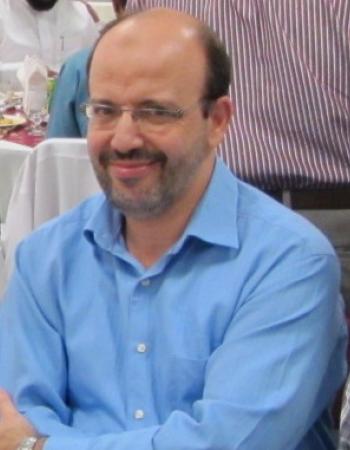A Comparative Study of Ru (II) Cyclometallated Versus Thiocyanated Heteroleptic Complexes: Thermodynamic Force for Efficient Dye Regeneration in Dye-sensitized Solar Cells and How Low Could it Be?
, M. Hussain, . 2014
Four novel Ru(II) bipyridyl complexes MH12–15 were synthesized and characterized for dye-sensitized solar cells (DSSCs). Their photovoltaic performance including incident photon-to-current conversion efficiency (IPCE), total solar-to-power conversion efficiency (η%) and ground and excited state oxidation potentials and photoelectrochemical properties were evaluated on mesoporous nanocrystalline TiO2 and compared with the benchmark N719-dye under the same experimental conditions. MH12–15 showed stronger MLCT with significantly higher molar extinction coefficient for the lower energy absorption bands at 553 nm (27 500 M−1 cm−1), 554 nm (34
500 M−1 cm−1), 554 nm (34 605 M−1 cm−1), 577 nm (23
605 M−1 cm−1), 577 nm (23 300 M−1 cm−1), and 582 nm (39
300 M−1 cm−1), and 582 nm (39 000 M−1 cm−1), respectively, than that of N719 (14
000 M−1 cm−1), respectively, than that of N719 (14 200 M−1 cm−1). The introduction of a cyclometallated ligand in dyes MH14and 15 improved the optical properties and red-shifts of 24 nm and 28 nm, respectively, compared to the non-cyclometallated analogs MH12 and 13. The red shift in the UV-Vis spectra of MH14 and 15 can be attributed to the destabilization of the HOMO t2g of Ru(II). However, the destabilization of the HOMO furnished an upward shift of the ground state oxidation potentials (GSOPs) of MH14 and 15 at −5.44 eV and −5.36 eV against vacuum, respectively, which resulted in a driving force of only 0.22 and 0.16 eV for regeneration of dyes MH14 and 15, respectively. In the case of NCS analogs, MH12 and 13, the GSOPs, however, were −5.56 and −5.51 eV, respectively, which produced a driving force of more than 0.25 eV for dye regeneration. The nanosecond transient absorbance measurements showed that the time needed for the oxidized forms of MH12–MH15 to regenerate the neutral dye is 6 μs, 4 μs, 13 μs and 18 μs, respectively, compared to N719 (2.3 μs). These kinetic data confirmed that the weak thermodynamic force, small negative free energy (−ΔG), for regeneration of MH14 and 15neutral dyes makes the dye regeneration process kinetically sluggish, which contributed significantly to the loss of both photocurrent and photovoltage. This study clearly elucidated that although cyclometallation may produce significantly better light harvesting, the driving force of less than 0.25 eV is not sufficiently enough for effective dye regeneration.
200 M−1 cm−1). The introduction of a cyclometallated ligand in dyes MH14and 15 improved the optical properties and red-shifts of 24 nm and 28 nm, respectively, compared to the non-cyclometallated analogs MH12 and 13. The red shift in the UV-Vis spectra of MH14 and 15 can be attributed to the destabilization of the HOMO t2g of Ru(II). However, the destabilization of the HOMO furnished an upward shift of the ground state oxidation potentials (GSOPs) of MH14 and 15 at −5.44 eV and −5.36 eV against vacuum, respectively, which resulted in a driving force of only 0.22 and 0.16 eV for regeneration of dyes MH14 and 15, respectively. In the case of NCS analogs, MH12 and 13, the GSOPs, however, were −5.56 and −5.51 eV, respectively, which produced a driving force of more than 0.25 eV for dye regeneration. The nanosecond transient absorbance measurements showed that the time needed for the oxidized forms of MH12–MH15 to regenerate the neutral dye is 6 μs, 4 μs, 13 μs and 18 μs, respectively, compared to N719 (2.3 μs). These kinetic data confirmed that the weak thermodynamic force, small negative free energy (−ΔG), for regeneration of MH14 and 15neutral dyes makes the dye regeneration process kinetically sluggish, which contributed significantly to the loss of both photocurrent and photovoltage. This study clearly elucidated that although cyclometallation may produce significantly better light harvesting, the driving force of less than 0.25 eV is not sufficiently enough for effective dye regeneration.

Four novel Ru(II) bipyridyl complexes MH12–15 were synthesized and characterized for dye-sensitized solar cells (DSSCs).

